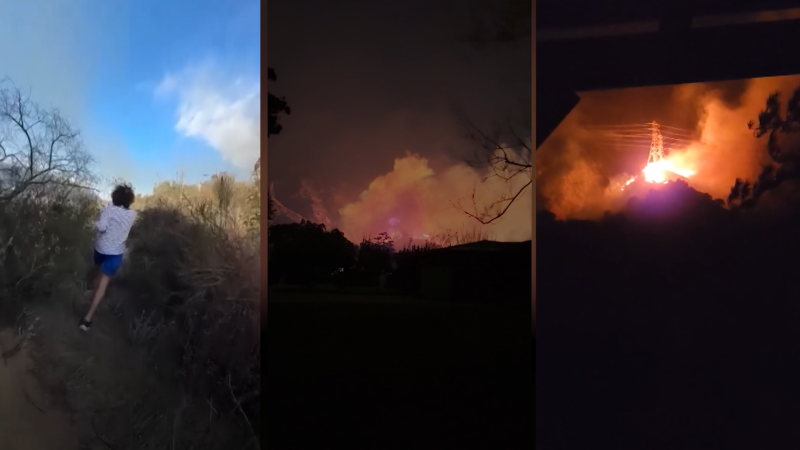Unveiling the Sparks: New Videos Suggest Early Origins of LA Wildfires
Recent footage from the heart of Los Angeles has ignited a firestorm of speculation regarding the origins of two significant wildfires that have recently swept through the region. As the flames ravaged vast areas, the emergence of this new video evidence has left experts scrambling to analyze the potential causes and implications of these alarming events. Understanding the early origins of these fires is crucial, not only for preventing future occurrences but also for safeguarding communities and the environment.
The Footage: What Was Captured
The recently surfaced videos show unsettling scenes of unusual activity in proximity to the areas where the wildfires began. Some clips depict individuals engaging in suspicious behavior, while others showcase what appears to be sparks or flames igniting in dry brush. The stark contrast between the serene landscape and the chaos that ensued has raised eyebrows and prompted further investigation.
- Location: The videos were primarily recorded in the northern and eastern outskirts of Los Angeles, areas often susceptible to wildfires due to their dry climate.
- Timing: Critical timestamps indicate that the footage was taken shortly before the fires erupted, suggesting a possible correlation.
- Witness Accounts: Several eyewitnesses reported seeing unusual activity in the vicinity, reinforcing the notion that human factors may play a role.
Expert Analysis: The Implications of Early Origins
Experts in wildfire management and environmental science have weighed in on the implications of this new evidence. They emphasize the importance of understanding not just the immediate causes of wildfires but also the broader context in which these events occur.
- Climate Change: As global temperatures rise, the conditions that lead to wildfires become more pronounced. Dry spells, heatwaves, and erratic weather patterns create a perfect storm for wildfires to ignite and spread.
- Urban-Wildland Interface: The growth of urban areas adjacent to wilderness regions increases the risk of human-caused ignitions. As cities expand, the potential for accidental fires rises significantly.
- Public Awareness: The footage may serve as a vital reminder of the need for community vigilance. Understanding the signs of potential fire hazards can empower residents to act before a situation escalates.
Human Factors: A Double-Edged Sword
While natural causes such as lightning strikes are often blamed for igniting wildfires, human activities frequently play a pivotal role. Whether through negligence or malicious intent, human factors must be taken into account when analyzing the origins of these fires.
Experts advise that a multi-faceted approach be taken to mitigate the risks associated with human-caused wildfires:
- Education: Increasing awareness about fire safety and prevention methods among residents can significantly reduce the number of accidental ignitions.
- Legislation: Stricter enforcement of fire safety regulations, especially during high-risk periods, can deter careless behavior that leads to fires.
- Community Programs: Engaging local communities in fire prevention initiatives can foster a sense of responsibility and collective action.
Technological Advancements in Wildfire Detection
As wildfires continue to pose a threat to Los Angeles and other regions, advancements in technology are becoming crucial in early detection and management. New tools and strategies are being developed to enhance monitoring and response capabilities:
- Satellite Imagery: High-resolution satellite images can help identify heat signatures and smoke, allowing for quicker response times.
- AI and Machine Learning: Algorithms can analyze patterns from historical wildfire data to predict future occurrences and potential hotspots.
- Drones: Unmanned aerial vehicles are increasingly being used to survey areas affected by wildfires, providing real-time data that can inform response strategies.
Community Resilience: Preparing for the Future
As Los Angeles grapples with the aftermath of these wildfires, fostering community resilience becomes imperative. Residents are encouraged to take proactive measures to prepare for fire season:
- Defensible Space: Homeowners should create defensible space around their properties by clearing flammable vegetation and maintaining well-watered landscapes.
- Emergency Plans: Having a clear evacuation plan and emergency kit can save lives and reduce panic during a wildfire event.
- Engagement with Local Fire Departments: Communities should actively engage with local fire services to stay informed about fire risks and prevention strategies.
Conclusion: A Call to Action
The recent footage unveiling the potential early origins of the LA wildfires serves as a stark reminder of the complexities surrounding wildfire management. As we delve deeper into the implications of this evidence, it becomes evident that a collaborative approach is essential. By harnessing technology, fostering community awareness, and implementing effective strategies, we can mitigate the risk of future wildfires.
While the threat of wildfires will always loom, it is our collective responsibility to remain vigilant and proactive. As residents of Los Angeles and beyond, we must work together to protect our communities, our environment, and our future. The sparks that ignite wildfires can be extinguished with knowledge, preparation, and a commitment to change.
See more Your Daily Weather



